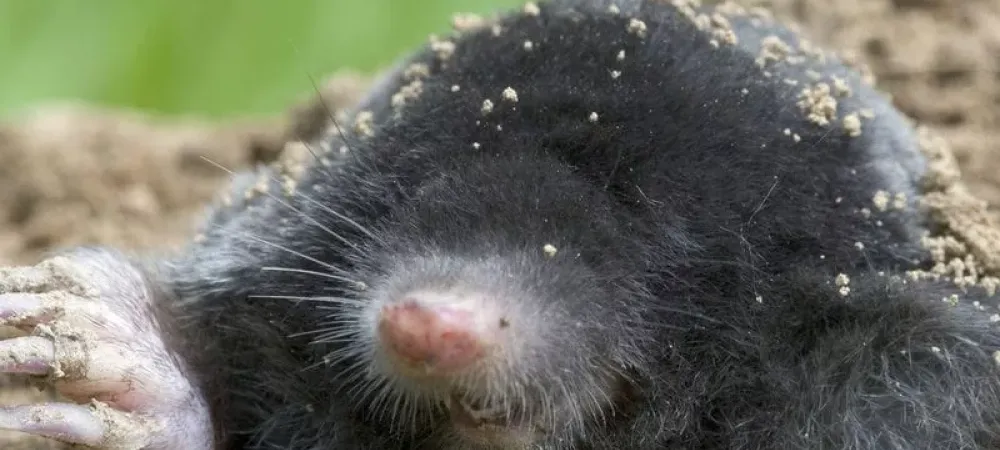This Is How To Get Rid Of Moles In Your Lawn

Moles may be the most destructive pest that can invade our yards. The damage they cause creates multiple problems and can ruin the overall look and structure of a lawn. The following are steps you can take to control current moles and prevent future problems.
How To Get Rid Of Moles
The damage moles cause is anything but subtle. They can dislodge garden plants and create ugly ruts in turfgrass. The tunnels they leave behind can be occupied with other rodents, like mice, voles, and rats. They’re active even in the winter, and they are a favorite host for fleas and ticks. And of course, there are the lovely “mole volcanoes” they create at the entrance to their tunnels. We’ve compiled a list of ways to get rid of moles, and they range from simply repelling them to outright trapping and killing them. We understand that the last option is not something everyone is comfortable with, so don’t worry. You don’t have to kill moles to oust them from your yard.
Take Away Their Food Source
The preferred source of food for moles is grubs. If you’re not familiar, grubs are the larvae of Japanese beetles. You probably won’t see them in their larval stage above the surface of the soil. However, if you’ve ever noticed c-shaped white bugs with brown heads when tilling the soil or planting a new flower, these are white moles crave. If moles weren’t so destructive, this would be an excellent thing for you and Mr. Mole. Grubs eat the roots of turfgrass and can cause spongy or bare patches of grass. So, on the one hand, moles eating grubs stop grubs from destroying your lawn. But on the other hand, moles leave behind a far more noticeable trail.
By eliminating grubs from your lawn, you will encourage moles to seek food elsewhere. It’s important to note that grubs are not the only source of food for moles. They will also dine on earthworms, spiders, centipedes, and other creepy crawlies.
Keep Up With Yardwork
Mowing, watering, and fertilizing your turf on a regular schedule can sometimes feel tedious. However, if you get lazy about it, you may end up with more than annoyingly long grass. Like many creatures, moles don’t like being disturbed. If you keep up with lawn maintenance, they’re less likely to pick your yard as the place to put down roots.
Install A Yard Barrier
If you’ve experienced persistent mole problems, you may need to install a barrier. Dig a trench about six inches wide and two feet deep. Fill it with rocks or pebbles and cover it back up with topsoil. This will deter moles from digging into the yard.
Trapping Moles
Trap And Release Method
Live traps are available if you’d prefer not to harm the mole. Be aware: you’ll need to drop the mole at least 5 miles away from your residence. Make sure to do so in a rural area that isn’t close to someone else’s yard.
Lethal Trap Method
If you’re comfortable with this method, you can buy lethal mole traps that will quickly and humanely end the animal’s life. You can purchase poison traps that are shaped like grubs and other insects. These need to be placed inside the molded tunnel, which can be tricky. Another option is a mechanical trap placed over the mole volcano and will kill the mole when it resurfaces.
Do-It-Yourself Mole Control
DIY is a great thing. It can help you learn and feel empowered as you handle problems on your own. Many DIY mole control options allegedly work. But the truth is, most don’t – more on those later.
If you’d like to try a gentler means of controlling moles before resorting to outright trapping or killing, try the following:
Mix three parts castor oil with one part dish soap. Add four tablespoons of this concentrated mixture to one gallon of water. Spray this on the tunnels and entry volcanoes. The mixture will make them sick and cause digestive distress. If they don’t like the taste of your yard, they may decide to leave.
Don’t Use These DIY Mole Control Methods
There are many folk remedies floating around on the internet that discuss do-it-yourself mole control options.
These things include but are not limited to:
- mothballs
- cayenne pepper
- Tea tree oil
- Broken glass
- Chewing gum
- Gasoline
Using any of the above is not only ineffective; some of them can be outright dangerous. Leaving bits of broken glass in the lawn can injure unsuspecting children, pets, and even yourself. And God forbid you run over it with the lawnmower…
When it comes to moles, it’s best to follow any other tips we’ve shared. Or you can leave it to the professionals.
Call A Pest Control Service
There’s nothing wrong with taking charge of your own yard, but that means dealing with not only the immediate problem of the moles but also repairing any damage they leave behind. Those tunnels they dug? They could turn your perfectly flat yard into a highway rumble strip. Good luck mowing over that without locking up the mower blades! Whether you don’t have the time or don’t want to deal with the mole problem yourself, there are pest control companies like Environmental Turf Management to handle it for you.
Get Professional Mole Control From Environmental Turf Management
Life is busy enough without having to deal with eradicating moles. Leave it to the experts at Environmental Turf Management! Our mole control for lawns and gardens swiftly removes these annoying critters. Plus, we can help you assess and repair the damage they’ve caused. If you’ve noticed mole mounds or tunnels, don’t wait. Give us a call today at 770-467-3851 or leave us a message online here.
To browse the latest deals and service offerings, follow us on Facebook and Twitter.



